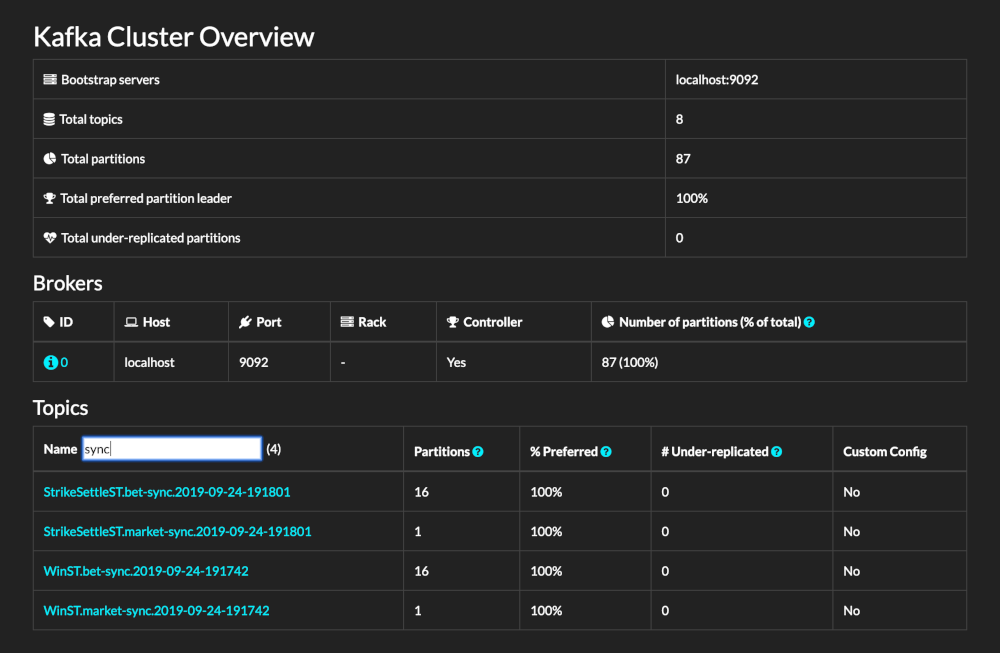Kafdrop is a web UI for viewing Kafka topics and browsing consumer groups. The tool displays information such as brokers, topics, partitions, consumers, and lets you view messages.
This project is a reboot of Kafdrop 2.x, dragged kicking and screaming into the world of JDK 11+, Kafka 2.x, Helm and Kubernetes. It's a lightweight application that runs on Spring Boot and is dead-easy to configure, supporting SASL and TLS-secured brokers.
- View Kafka brokers — topic and partition assignments, and controller status
- View topics — partition count, replication status, and custom configuration
- Browse messages — JSON, plain text, Avro and Protobuf encoding
- View consumer groups — per-partition parked offsets, combined and per-partition lag
- Create new topics
- View ACLs
- Support for Azure Event Hubs
- Java 11 or newer
- Kafka (version 0.11.0 or newer) or Azure Event Hubs
Optional, additional integration:
- Schema Registry
You can run the Kafdrop JAR directly, via Docker, or in Kubernetes.
java --add-opens=java.base/sun.nio.ch=ALL-UNNAMED \
-jar target/kafdrop-<version>.jar \
--kafka.brokerConnect=<host:port,host:port>,...If unspecified, kafka.brokerConnect defaults to localhost:9092.
Note: As of Kafdrop 3.10.0, a ZooKeeper connection is no longer required. All necessary cluster information is retrieved via the Kafka admin API.
Open a browser and navigate to http://localhost:9000. The port can be overridden by adding the following config:
--server.port=<port> --management.server.port=<port>
Optionally, configure a schema registry connection with:
--schemaregistry.connect=http://localhost:8081
and if you also require basic auth for your schema registry connection you should add:
--schemaregistry.auth=username:password
Finally, a default message format (e.g. to deserialize Avro messages) can optionally be configured as follows:
--message.format=AVRO
Valid format values are DEFAULT, AVRO, PROTOBUF. This can also be configured at the topic level via dropdown when viewing messages.
In case of protobuf message type, the definition of a message could be compiled and transmitted using a descriptor file. Thus, in order for kafdrop to recognize the message, the application will need to access to the descriptor file(s). Kafdrop will allow user to select descriptor and well as specifying name of one of the message type provided by the descriptor at runtime.
To configure a folder with protobuf descriptor file(s) (.desc), follow:
--protobufdesc.directory=/var/protobuf_desc
In case of no protobuf descriptor file being supplied the implementation will attempt to create the protobuf deserializer using the schema registry instead.
If preferred the message type could be set to default as follows:
--message.format=PROTOBUF
Images are hosted at hub.docker.com/r/obsidiandynamics/kafdrop.
Launch container in background:
docker run -d --rm -p 9000:9000 \
-e KAFKA_BROKERCONNECT=<host:port,host:port> \
-e JVM_OPTS="-Xms32M -Xmx64M" \
-e SERVER_SERVLET_CONTEXTPATH="/" \
obsidiandynamics/kafdropLaunch container in background with protobuff definitions:
docker run -d --rm -v <path_to_protobuff_descriptor_files>:/var/protobuf_desc -p 9000:9000 \
-e KAFKA_BROKERCONNECT=<host:port,host:port> \
-e JVM_OPTS="-Xms32M -Xmx64M" \
-e SERVER_SERVLET_CONTEXTPATH="/" \
-e CMD_ARGS="--message.format=PROTOBUF --protobufdesc.directory=/var/protobuf_desc" \
obsidiandynamics/kafdropThen access the web UI at http://localhost:9000.
Hey there! We hope you really like Kafdrop! Please take a moment to ⭐the repo or Tweet about it.
Clone the repository (if necessary):
git clone https://github.com/obsidiandynamics/kafdrop && cd kafdropApply the chart:
helm upgrade -i kafdrop chart --set image.tag=3.x.x \
--set kafka.brokerConnect=<host:port,host:port> \
--set server.servlet.contextPath="/" \
--set cmdArgs="--message.format=AVRO --schemaregistry.connect=http://localhost:8080" \ #optional
--set jvm.opts="-Xms32M -Xmx64M"For all Helm configuration options, have a peek into chart/values.yaml.
Replace 3.x.x with the image tag of obsidiandynamics/kafdrop. Services will be bound on port 9000 by default (node port 30900).
Note: The context path must begin with a slash.
Proxy to the Kubernetes cluster:
kubectl proxyNavigate to http://localhost:8001/api/v1/namespaces/default/services/http:kafdrop:9000/proxy.
To install with protobuf support, a "facility" option is provided for the deployment, to mount the descriptor files folder, as well as passing the required CMD arguments, via option mountProtoDesc. Example:
helm upgrade -i kafdrop chart --set image.tag=3.x.x \
--set kafka.brokerConnect=<host:port,host:port> \
--set server.servlet.contextPath="/" \
--set mountProtoDesc.enabled=true \
--set mountProtoDesc.hostPath="<path/to/desc/folder>" \
--set jvm.opts="-Xms32M -Xmx64M"After cloning the repository, building is just a matter of running a standard Maven build:
$ mvn clean packageThe following command will generate a Docker image:
mvn assembly:single docker:buildThere is a docker-compose.yaml file that bundles a Kafka/ZooKeeper instance with Kafdrop:
cd docker-compose/kafka-kafdrop
docker-compose upStarting with version 2.0.0, Kafdrop offers a set of Kafka APIs that mirror the existing HTML views. Any existing endpoint can be returned as JSON by simply setting the Accept: application/json header. Some endpoints are JSON only:
/topic: Returns a list of all topics.
To help document the Kafka APIs, Swagger has been included. The Swagger output is available by default at the following Kafdrop URL:
/v2/api-docs
This can be overridden with the following configuration:
springfox.documentation.swagger.v2.path=/new/swagger/path
Currently only the JSON endpoints are included in the Swagger output; the HTML views and Spring Boot debug endpoints are excluded.
You can disable Swagger output with the following configuration:
swagger.enabled=false
Starting in version 2.0.0, Kafdrop sets CORS headers for all endpoints. You can control the CORS header values with the following configurations:
cors.allowOrigins (default is *)
cors.allowMethods (default is GET,POST,PUT,DELETE)
cors.maxAge (default is 3600)
cors.allowCredentials (default is true)
cors.allowHeaders (default is Origin,Accept,X-Requested-With,Content-Type,Access-Control-Request-Method,Access-Control-Request-Headers,Authorization)
You can also disable CORS entirely with the following configuration:
cors.enabled=false
By default, you could delete a topic. If you don't want this feature, you could disable it with:
--topic.deleteEnabled=false
By default, you could create a topic. If you don't want this feature, you could disable it with:
--topic.createEnabled=false
Health and info endpoints are available at the following path: /actuator
This can be overridden with the following configuration:
management.endpoints.web.base-path=<path>
Kafdrop supports TLS (SSL) and SASL connections for encryption and authentication. This can be configured by providing a combination of the following files (placed into the Kafka root directory):
kafka.truststore.jks: specifying the certificate for authenticating brokers, if TLS is enabled.kafka.keystore.jks: specifying the private key to authenticate the client to the broker, if mutual TLS authentication is required.kafka.properties: specifying the necessary configuration, including key/truststore passwords, cipher suites, enabled TLS protocol versions, username/password pairs, etc. When supplying the truststore and/or keystore files, thessl.truststore.locationandssl.keystore.locationproperties will be assigned automatically.
The three files above can be supplied to a Docker instance in base-64-encoded form via environment variables:
docker run -d --rm -p 9000:9000 \
-e KAFKA_BROKERCONNECT=<host:port,host:port> \
-e KAFKA_PROPERTIES="$(cat kafka.properties | base64)" \
-e KAFKA_TRUSTSTORE="$(cat kafka.truststore.jks | base64)" \ # optional
-e KAFKA_KEYSTORE="$(cat kafka.keystore.jks | base64)" \ # optional
obsidiandynamics/kafdrop| Name | Description |
|---|---|
KAFKA_BROKERCONNECT |
Bootstrap list of Kafka host/port pairs. Defaults to localhost:9092. |
KAFKA_PROPERTIES |
Additional properties to configure the broker connection (base-64 encoded). |
KAFKA_TRUSTSTORE |
Certificate for broker authentication (base-64 encoded). Required for TLS/SSL. |
KAFKA_KEYSTORE |
Private key for mutual TLS authentication (base-64 encoded). |
SERVER_SERVLET_CONTEXTPATH |
The context path to serve requests on (must end with a /). Defaults to /. |
SERVER_PORT |
The web server port to listen on. Defaults to 9000. |
SCHEMAREGISTRY_CONNECT |
The endpoint of Schema Registry for Avro or Protobuf message |
SCHEMAREGISTRY_AUTH |
Optional basic auth credentials in the form username:password. |
CMD_ARGS |
Command line arguments to Kafdrop, e.g. --message.format or --protobufdesc.directory or --server.port. |
| Name | Description |
|---|---|
JVM_OPTS |
JVM options. |
JMX_PORT |
Port to use for JMX. No default; if unspecified, JMX will not be exposed. |
HOST |
The hostname to report for the RMI registry (used for JMX). Defaults to localhost. |
KAFKA_PROPERTIES_FILE |
Internal location where the Kafka properties file will be written to (if KAFKA_PROPERTIES is set). Defaults to kafka.properties. |
KAFKA_TRUSTSTORE_FILE |
Internal location where the truststore file will be written to (if KAFKA_TRUSTSTORE is set). Defaults to kafka.truststore.jks. |
KAFKA_KEYSTORE_FILE |
Internal location where the keystore file will be written to (if KAFKA_KEYSTORE is set). Defaults to kafka.keystore.jks. |
SSL_ENABLED |
Enabling HTTPS (SSL) for Kafdrop server. Default is false |
SSL_KEY_STORE_TYPE |
Type of SSL keystore. Default is PKCS12 |
SSL_KEY_STORE |
Path to keystore file |
SSL_KEY_STORE_PASSWORD |
Keystore password |
SSL_KEY_ALIAS |
Key alias |
Like in the Docker example, supply the files in base-64 form:
helm upgrade -i kafdrop chart --set image.tag=3.x.x \
--set kafka.brokerConnect=<host:port,host:port> \
--set kafka.properties="$(cat kafka.properties | base64)" \
--set kafka.truststore="$(cat kafka.truststore.jks | base64)" \
--set kafka.keystore="$(cat kafka.keystore.jks | base64)"Edit the .scss files in the theme directory, then run theme/install.sh. This will overwrite src/main/resources/static/css/bootstrap.min.css. Then build as usual. (Requires npm.)
Kafdrop doesn't (yet) natively implement an authentication mechanism to restrict user access. Here's a quick workaround using NGINX using Basic Auth. The instructions below are for macOS and Homebrew.
- NGINX: install using
which nginx > /dev/null || brew install nginx - Apache HTTP utilities:
which htpasswd > /dev/null || brew install httpd
Set the admin password (you will be prompted):
htpasswd -c /usr/local/etc/nginx/.htpasswd adminAdd a logout page in /usr/local/opt/nginx/html/401.html:
<!DOCTYPE html>
<p>Not authorized. <a href="<!--# echo var="scheme" -->://<!--# echo var="http_host" -->/">Login</a>.</p>Use the following snippet for /usr/local/etc/nginx/nginx.conf:
worker_processes 4;
events {
worker_connections 1024;
}
http {
upstream kafdrop {
server 127.0.0.1:9000;
keepalive 64;
}
server {
listen *:8080;
server_name _;
access_log /usr/local/var/log/nginx/nginx.access.log;
error_log /usr/local/var/log/nginx/nginx.error.log;
auth_basic "Restricted Area";
auth_basic_user_file /usr/local/etc/nginx/.htpasswd;
location / {
proxy_pass http://kafdrop;
}
location /logout {
return 401;
}
error_page 401 /errors/401.html;
location /errors {
auth_basic off;
ssi on;
alias /usr/local/opt/nginx/html;
}
}
}
Run NGINX:
nginxOr reload its configuration if already running:
nginx -s reloadTo logout, browse to /logout.
Hey there! We hope you really like Kafdrop! Please take a moment to ⭐the repo or Tweet about it.
All contributions are more than welcomed. Contributions may close an issue, fix a bug (reported or not reported), add new design blocks, improve the existing code, add new feature, and so on. In the interest of fostering an open and welcoming environment, we as contributors and maintainers pledge to making participation in our project and our community a harassment-free experience for everyone.
To cut an official release, these are the steps:
-
Commit a new version on master that has the
-SNAPSHOTsuffix stripped (seepom.xml). Once the commit is merged, the CI will treat it as a release build, and will end up publishing more artifacts than the regular (non-release/snapshot) build. One of those will be a dockerhub push to the specific version and "latest" tags. (The regular build doesn't update "latest"). -
You can then edit the release description in GitHub to describe what went into the release.
-
After the release goes through successfully, you need to prepare the repo for the next version, which requires committing the next snapshot version on master again. So we should increment the minor version and add again the
-SNAPSHOTsuffix.





